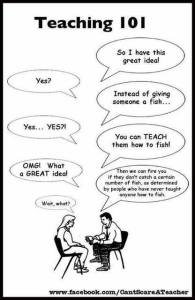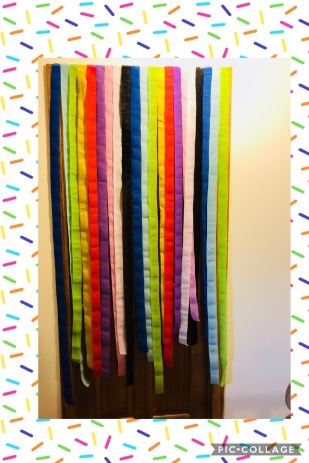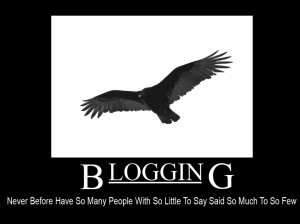
A friend and colleague of mine posted this little comic on facebook today, and it at least made me think a little bit…ok, quite a bit. There are multiple ways to go with this–the legitimacy of standardized tests as indicators of performance (teacher or student), merit pay, teacher motivation (which is not actually increased by merit pay), and what it is we actually teach. Let’s talk about that–the skills, knowledge, and dispositions that our students need to learn.
Since we have this fishing analogy in front of us, I’m just going to expand on it a bit. I think we can all agree that the idea of teaching somebody to fish is more sustainable than just giving them a fish. Applicable. I can work with that. So now, we decide that a kid needs to know how to fish (answer questions), and we’re going to measure how well they do on a given day. I can work with that, too. But now, we’re going to hold the teacher accountable for all kids catching a certain number of fish on that given day. Then, instead of analyzing results and working with an almost certainly skilled individual (the teacher) to respond to those results, we’re going to get punitive. This is where I struggle. Here’s why.
Do you know how many ways there are to fish? Countless. But let’s go with the basics of bare hands, nets, traps or set nets, spears, or using a hook and line (maybe even a sinker…wah, wah, wah). Now, some of these methods might pull in a large quantity of fish in short time, while others take longer to catch anything. Some might take a long time to master, but then be fairly reliable. The time needed to master a given technique may have much to do with a person’s culture, upbringing, or family support. You get the picture, different techniques of fishing (answering questions) will take varying amounts of time for different kids to master, and even so, some may have better levels of success. What if on the given time and day to catch your fish, you’re just not quite ready?
Those levels of success will also be susceptible to a myriad of conditions–type of fish in the water, cleanliness of the water, fish population, presence of predators, etc. Furthermore, the fishermen (students) will have access to different tools. Some will have boats, depth finders, the latest rod and reel, bait specifically intended to pull in the desired catch, a cool drink and snacks to sustain them while they fish, maybe even good company in their effort. Some will have access to multiple bodies of water with good opportunity to catch fish, and others will be stuck on dry land or in concrete jungles. Should all of these fishermen be held to the same standard or quota? We can argue for an objective standard and say “yes.” In which case, I will say that we need to do more with the data than evaluate the fishing pro’s performance.
All of this aside, let’s also ask ourselves if we know that the fishing we’re teaching is the best. When we determine a certain number of fish that need to be caught (questions that need to be answered) and a preferred method for attaining the required results, we narrow our focus. I don’t know if you want to be fly fishing, deep sea fishing, ice fishing, trolling a line behind your boat, entering a fishing contest, or standing on the dock with a kid casting their first line. There are infinite goals and directions we can set for ourselves (or discover along the way), and I will venture that we all have many questions to ask and answer to get there. We need to foster our students’ ability to ask good questions, seek effective solutions, learn from mistakes, and change direction as needed. We also need to allow for our students to encounter meaningful ways to contribute to society and find fulfillment in their lives. This will look very different for different students.
What happens when we make a teacher’s livelihood dependent on the fish their students catch? Yes, the students will have other factors that influence their performance beyond the teacher’s control. But even more frightening is that the teacher will develop a laser-like focus on the skills needed to catch the fish that somebody else said are most important. The only reason that’s a problem is that in order to do that, they will cut out many of the other lessons that are indispensable for our students’ preparation for life. And what will the basis for their decisions be? It’s much more likely to be fear of punishment or humiliation than care for their students’ best interests.
And what do we say to the student who decides to try hunting or wants to start a garden and be a vegan? Sorry, you must fish well.
 My daughter and I just decorated her door with streamers. She’s been asking to do this for several days. I’ve had the typical responses to helping her, “Sure…later,” “Not now; we’re too busy,” “Uh huh, but I have to do x, y, z first.” You know the story. There’s a lot going on. People are waiting on us. The family needs to be fed, the counter needs to get cleaned off (again!), and the laundry…don’t even go there!
My daughter and I just decorated her door with streamers. She’s been asking to do this for several days. I’ve had the typical responses to helping her, “Sure…later,” “Not now; we’re too busy,” “Uh huh, but I have to do x, y, z first.” You know the story. There’s a lot going on. People are waiting on us. The family needs to be fed, the counter needs to get cleaned off (again!), and the laundry…don’t even go there!
